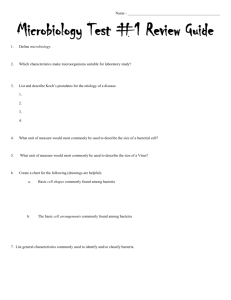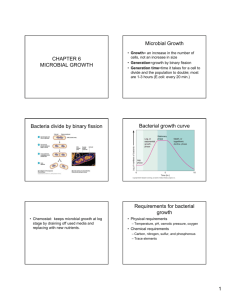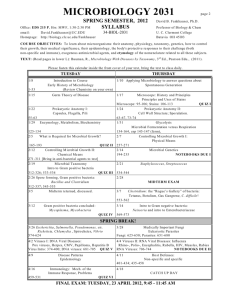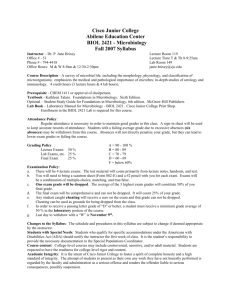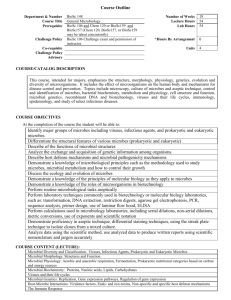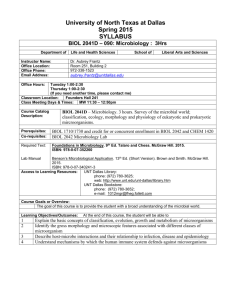BISC 2337 - Department of Biological Sciences
advertisement
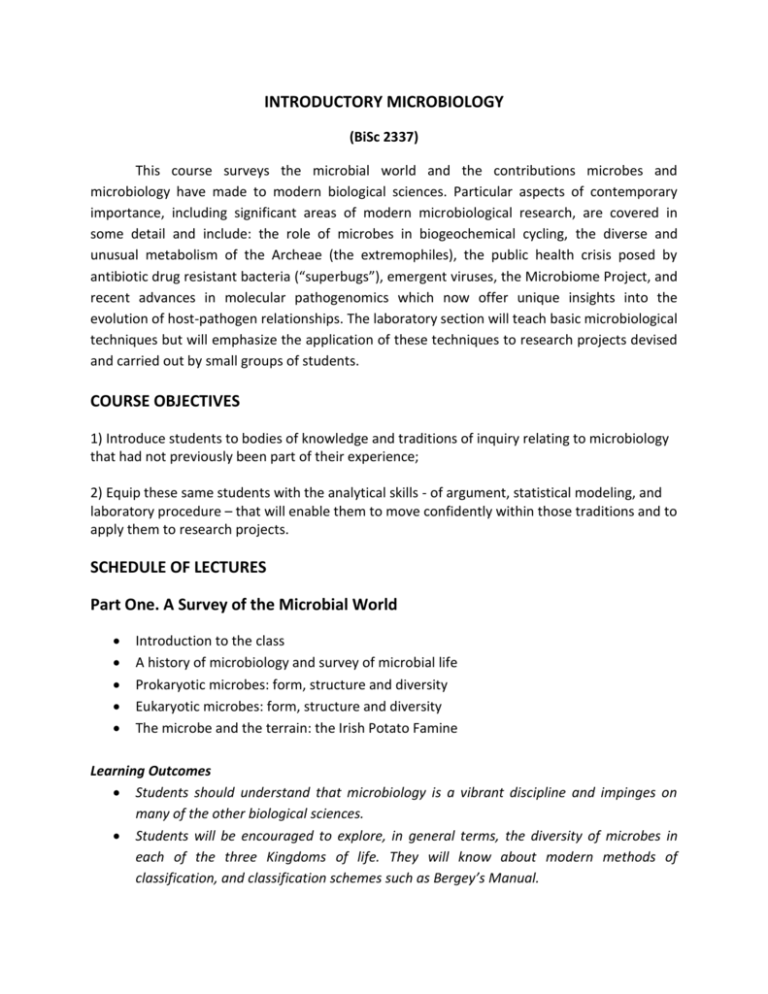
INTRODUCTORY MICROBIOLOGY (BiSc 2337) This course surveys the microbial world and the contributions microbes and microbiology have made to modern biological sciences. Particular aspects of contemporary importance, including significant areas of modern microbiological research, are covered in some detail and include: the role of microbes in biogeochemical cycling, the diverse and unusual metabolism of the Archeae (the extremophiles), the public health crisis posed by antibiotic drug resistant bacteria (“superbugs”), emergent viruses, the Microbiome Project, and recent advances in molecular pathogenomics which now offer unique insights into the evolution of host-pathogen relationships. The laboratory section will teach basic microbiological techniques but will emphasize the application of these techniques to research projects devised and carried out by small groups of students. COURSE OBJECTIVES 1) Introduce students to bodies of knowledge and traditions of inquiry relating to microbiology that had not previously been part of their experience; 2) Equip these same students with the analytical skills - of argument, statistical modeling, and laboratory procedure – that will enable them to move confidently within those traditions and to apply them to research projects. SCHEDULE OF LECTURES Part One. A Survey of the Microbial World Introduction to the class A history of microbiology and survey of microbial life Prokaryotic microbes: form, structure and diversity Eukaryotic microbes: form, structure and diversity The microbe and the terrain: the Irish Potato Famine Learning Outcomes Students should understand that microbiology is a vibrant discipline and impinges on many of the other biological sciences. Students will be encouraged to explore, in general terms, the diversity of microbes in each of the three Kingdoms of life. They will know about modern methods of classification, and classification schemes such as Bergey’s Manual. Students will understand that bacteria are essentially colonial organisms and many undergo both cellular and colonial differentiation during their life cycles. Students will develop an understanding of the major theories of microbiology, principally monomorphism and the fixity of microbial form and function, the Germ Theory (in its traditional and “molecular” manifestations), and the “pleiomorphic” view of microbes that emphasizes cellular and colonial dynamism in response to environmental stimuli. Part Two. Microbial Nutrition and Metabolism Growth, nutrition and metabolism of microbes Factors affecting growth Microbial ecology: biogeochemical cycles and biodegradation The extremophiles Learning Outcomes Students will gain an understanding of how microbes grow, how growth is measure, and how it can be manipulated for microbial isolation and characterization. Students will know the nutritional needs and nutritional diversity of microbes, and the basics of carbon and energy metabolism. Students will be aware of the differences and similarities between photoautotrophs, photoheterotrophs, chemoautotrophs and chemoheterotrophs. Students will appreciate the role of microorganisms in biogeochemical pathways and the special importance of the “extremophiles”. Students will understand how these aspects have been applied to agricultural, environmental and industrial microbiology. Part Three. Microbial Genetics The genetic diversity of microbes Gene regulation in microbes Genetic transfer and recombination Learning Outcomes Students will be aware the nature of the genetic material in bacteria, the function of extrachromosomal DNA, and the concepts of “The Unity of Plasmid Biology”. Students will learn how genes are regulated in bacteria (the operon theory) but also how cellular regulation (phosphotransferase systems, two-component signal transduction, etc.) operates in nutrition, motility and response to environmental fluctuations. Students will comprehend how gene exchange occurs in bacteria and how these phenomena have been utilized for studies on bacterial genetics and the invention of recombinant DNA technology and its applications. Part Four. Antibiotic Resistance and Bacterial Evolution Antibiotics and antibiotic resistance Plasmids and transposable DNA Horizontal gene transfer (HGT) and the generation of bacterial diversity Learning Outcomes Students will learn how antibiotics were discovered and their mechanisms of action against bacteria. Students will be cognizant of the current public health threat posed by antibiotic resistance and how this has arisen, including the role of R plasmids and transposable elements, horizontal gene transfer, and the prolific use of antibiotics in medicine and agriculture. Students will be aware of alternative therapies, such as phage therapy, probiotics, and antimicrobial peptides. Students will know how horizontal gene transfer has contributed to bacterial diversity and evolution. Part Four. Viruses, Viroids and Prions Viruses Emerging viruses Pandemic influenza Prions Learning Outcomes Students will be able to relate the biology of viruses and viral infection in bacteria, plants and animals. They will be able to explain the infective cycle of DNA and RNA viruses, and the nature of lysogeny in bacteria and transformation in animal cells. Students will be aware of the nature and scope of viral zoonoses and the causes and consequences of emerging viral diseases, with examples. Students will be able to explain the infective cycle of influenza viruses and the evolution of flu viruses through antigenic shift and antigenic drift and the emergence of “Avian Flu”. They will understand the current theories explaining the emergence of influenza and other viral epidemics and pandemics. Students will learn about the prion diseases, the fundaments of the “Prion Hypopthesis”, and the controversial challenge that prions pose for modern biology. Part Five. Microbes and Disease Microbes and disease: the basic principles of pathogenesis The human microbiota and the Microbiome Project Biological warfare Molecular pathogenicity: the “eco-evo” view of microbial disease The natural history of infectious diseases: cholera, bubonic plague and tuberculosis Learning Outcomes Students will know about the modern definitions and concepts of bacterial pathogenesis and bacterial virulence. They will understand virulence factors and their role in pathogenesis, and the organization and evolution of virulence genes as revealed by contemporary genomic studies (molecular pathogenomics). Students will learn about host defense mechanisms against bacterial infection and will be particularly aware of the role played by the host’s microbiota and the scope of the Human Microbiome Project (HMP). Students will have a broad knowledge about microbial diseases in humans, with examples, and how disease etiology is affected by environmental and evolutionary factors (the “eco-evo” view of infectious disease). SCHEDULE OF LABORATORIES Orientation. Oil immersion microscopy. Bacterial shapes and aggregates Basic microbiological techniques. Simple staining, gram staining and spore staining. Growth of bacteria on basic and selective media. Techniques for establishing pure culture. Learning Outcomes The use of the microscope, staining techniques and live mounts for assessing bacterial shape, aggregation and motility will be second nature to students. They will be expert in aseptic technique, pure culture methods and the use of cultural and physical techniques for the enrichment, isolation and differentiation of microbes. Quantitative methods. The use of selective and differential media. Biochemical characteristics of microbes. Diagnostic testing. Environmental, water and food microbiology. Learning Outcomes o Students will be able to choose and use selective and differential media and routine physiological/biochemical tests to identify different bacterial types. o Students will be capable of quantifying bacteria from a variety of sources (food, soil, water) using viable count methods and water filtration methods. o Students will know how to apply these techniques for standard microbial evaluations of food, milk and water samples. First project: isolation and characterization of bacteria from natural habitats. Learning Outcomes Students will learn how to develop and carry out simple independent research projects on the isolation, quantification and characterization of microbes, by applying the techniques they have learned previously. Students will be able to formulate their research plans in the form of a written proposal. Students will be given experience in communicating their results and conclusions in the writing of a formal research paper. Genetic and molecular techniques. Transformation. Antimicrobial assays: Kirby-Bauer, MIC and MKC determinations. Testing for antibiotic resistance. Plasmid DNA isolation. Agarose gel electrophoresis. Bacteriophage titration and characterization. Learning Outcomes o Students will learn how to apply and interpret standard techniques for for assessing antimicrobial compounds and antibiotics. o Students will have experience in DNA purification procedures and the characterization of plasmid DNA by agarose gel electrophoresis and PCR. o Students will be able to identify and quantify bacteriophages using standard techniques. o Students will know how to apply transformation, transduction and transfection to bacterial cell lines to demonstrate the transfer of antibiotic resistance genes. Second project: Multiple antibiotic drug resistance: R Plasmid characterization: Isolation and characterization of bio-protective properties of herbs and spices. ASSIGNMENTS Examinations. Three take-home examinations will be scheduled for the semester. The examinations will be comprehensive and will test your ability to interpret experimental data, devise experiments to investigate certain assumptions, and research topics in contemporary microbiology. (40% of the total grade.) Proposal. You will be carrying out two research projects during the semester: for the first (and major project), you will be required to write a short research proposal. Instructions will be given in class and posted on Blackboard. (20% of the total grade.) Research Papers. You will write two research papers this semester based upon the two projects you carry out in the laboratory section. Full instructions, as before, will be provided at the time and made available on Blackboard. (First paper: 25% of the total grade; second paper: 15% of the total grade.) Written assignments (proposal and first research paper), once graded, may be revised and resubmitted at the instructor’s discretion: final grades for the assignment will then be based on the average score for both submissions. GRADING SCALE Score Grade >95 A 94-90 A- 89-85 B+ 84-80 B 79-75 B- 74-70 C+ 69-65 C 64-60 C- 59-55 D CLASS AND EXAMINATIONS POLICIES Complete attendance of lectures and laboratories is required. Regular roll-calls will be taken. Students who cannot attend a lecture or laboratory must inform the instructor beforehand. Delinquent students will be issued one warning only: thereafter, continued failure to attend classes will result in either a lowered grade or dismissal from, and failure of, the course. All assignments are due on the appointed dates. Late submissions will not be graded. Exceptions will be considered only in the case of illness (when a doctor’s note will be required) or family emergency. You are expected to be familiar with and abide by the Code of Academic Integrity. Any violation will be reported at once to the Office of Academic Integrity and may result in immediate dismissal from the course TEXTBOOKS A Photographic Atlas for the Microbiology Laboratory (Fourth Edition). M.J. Leboffe and B.E. Pierce (available in the bookstore) Todar’s Online Textbook of Bacteriology. www.textbookofbacteriology.net A Laboratory Guide to Microbiology, Department of Biological Sciences, The George Washington University (available in class and on Blackboard) Consult Announcements and Files on Blackboard regularly for laboratory manual updates, key research papers and other course materials. INSTRUCTOR David Morris 349 Lisner Hall, 404 Bell Hall 994-3882; 994-0996. E-mail: morrisd@gwu.edu Office hours: Tuesday and Thursday between 8 and 10 in the mornings.


